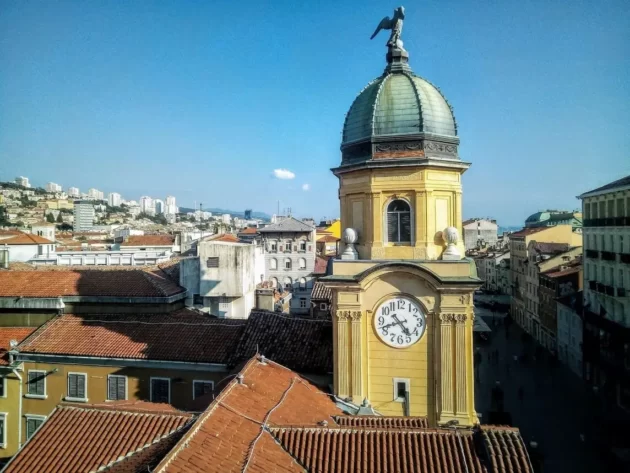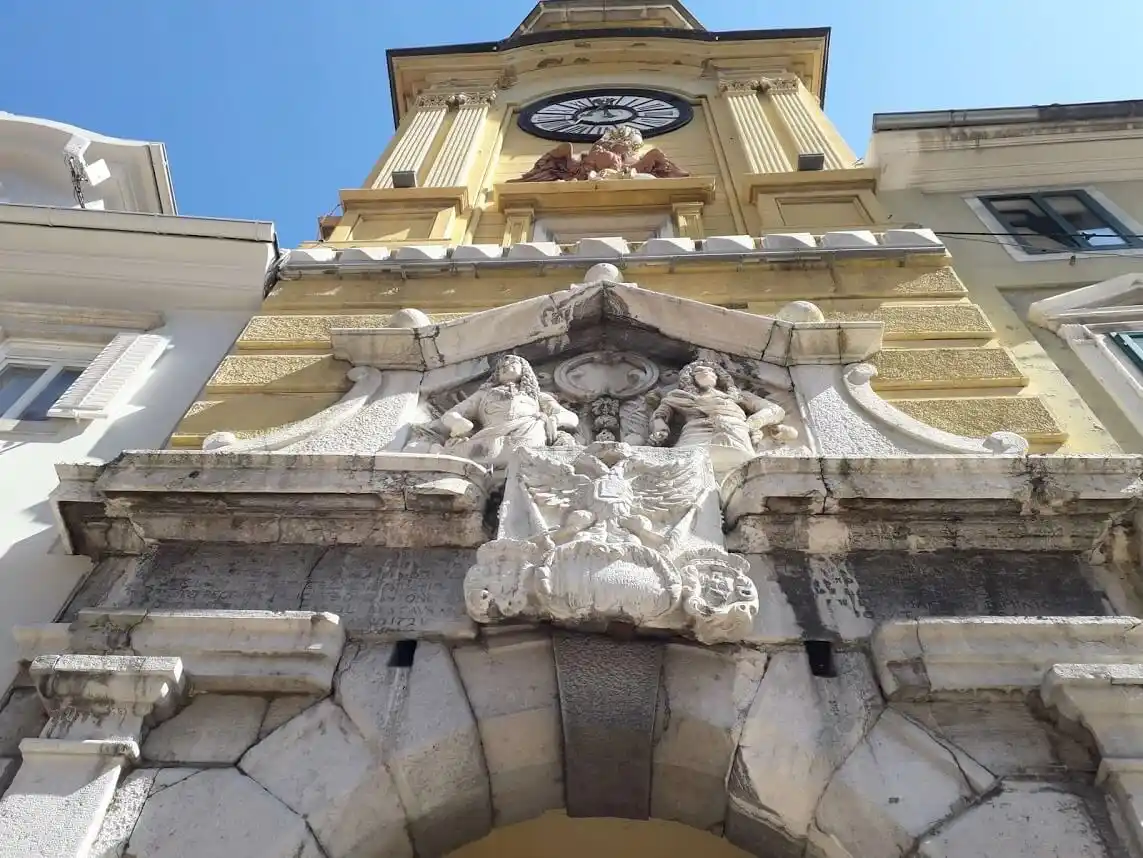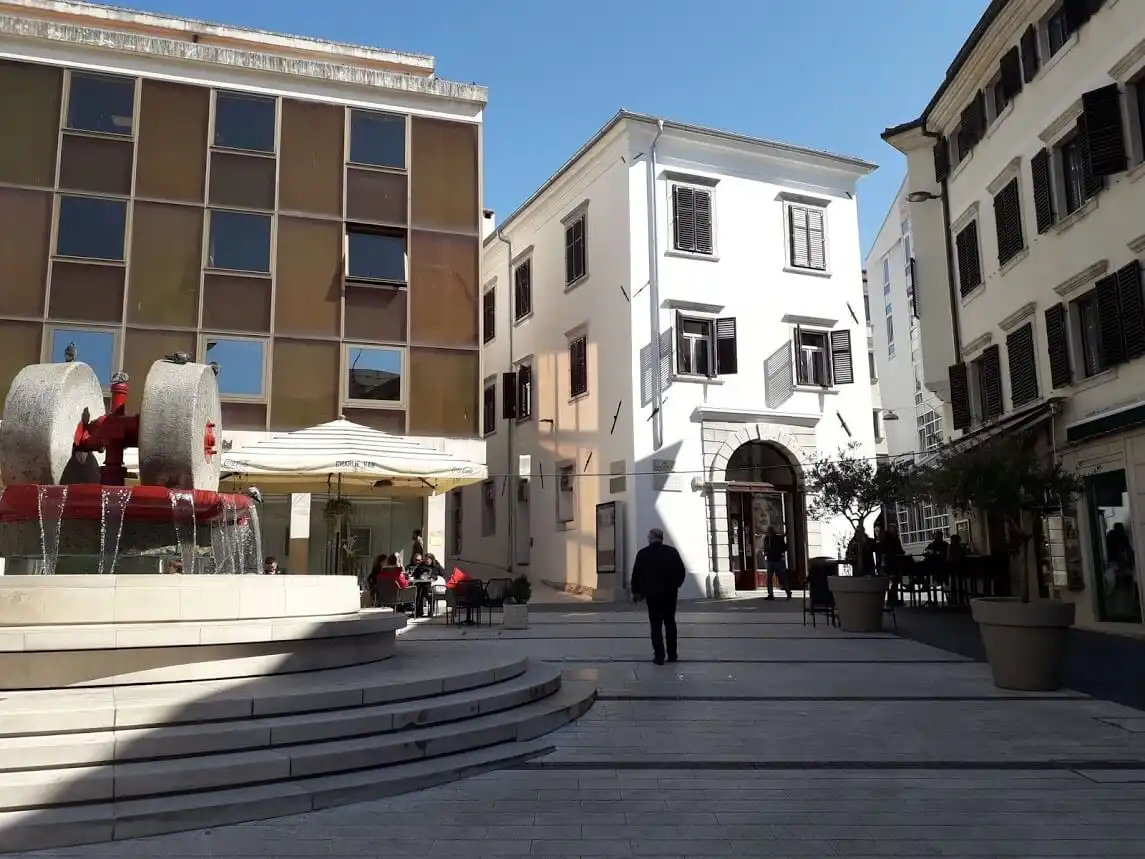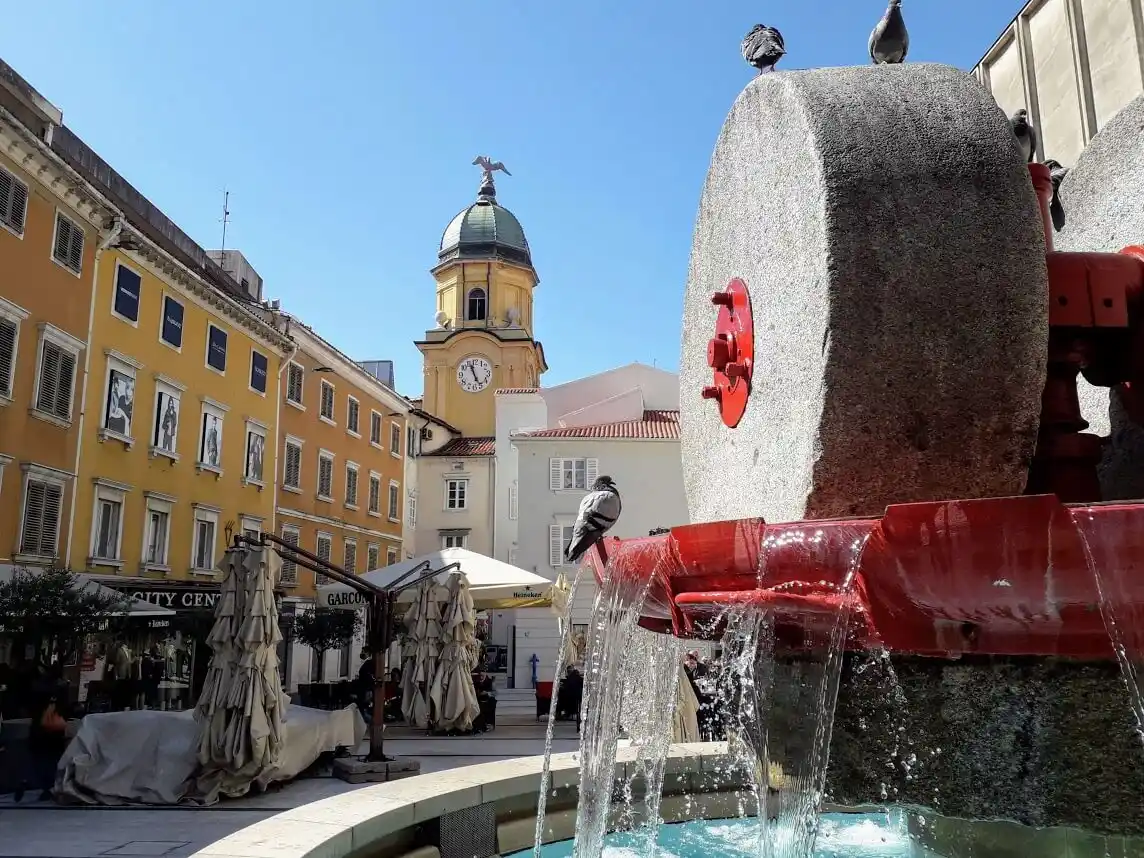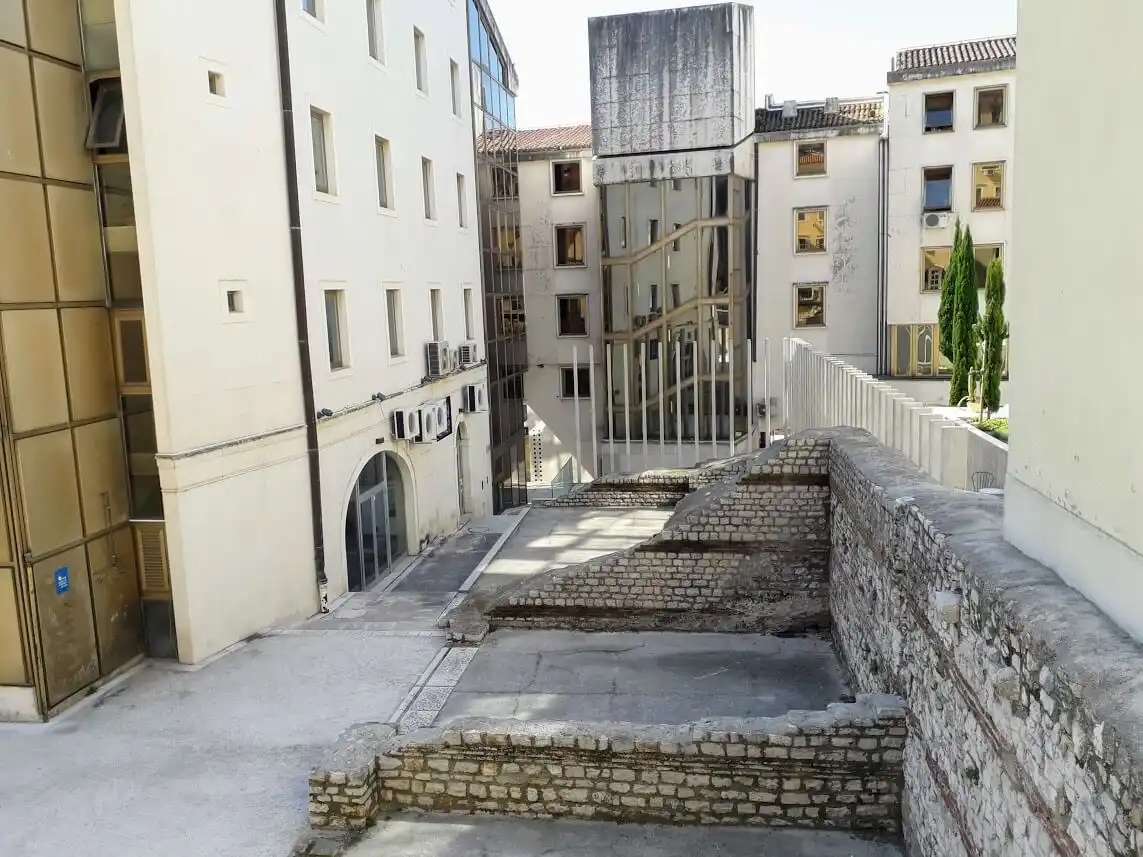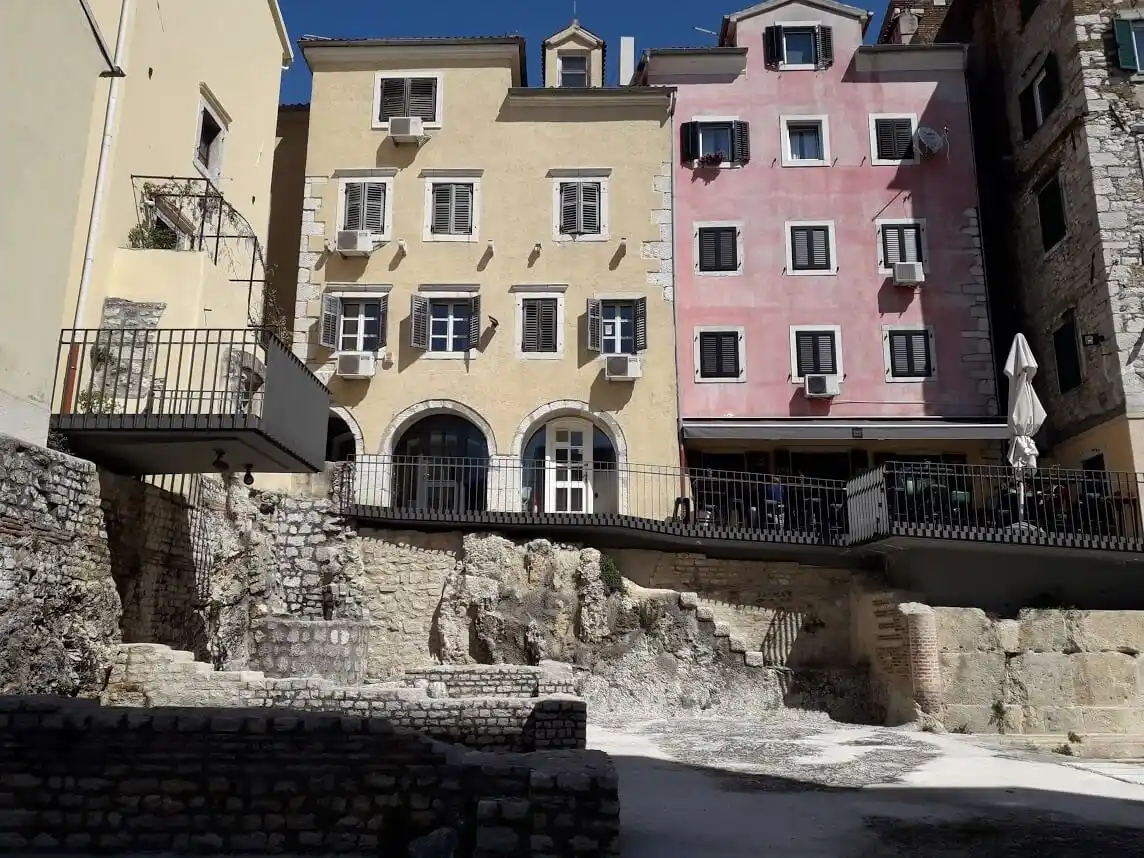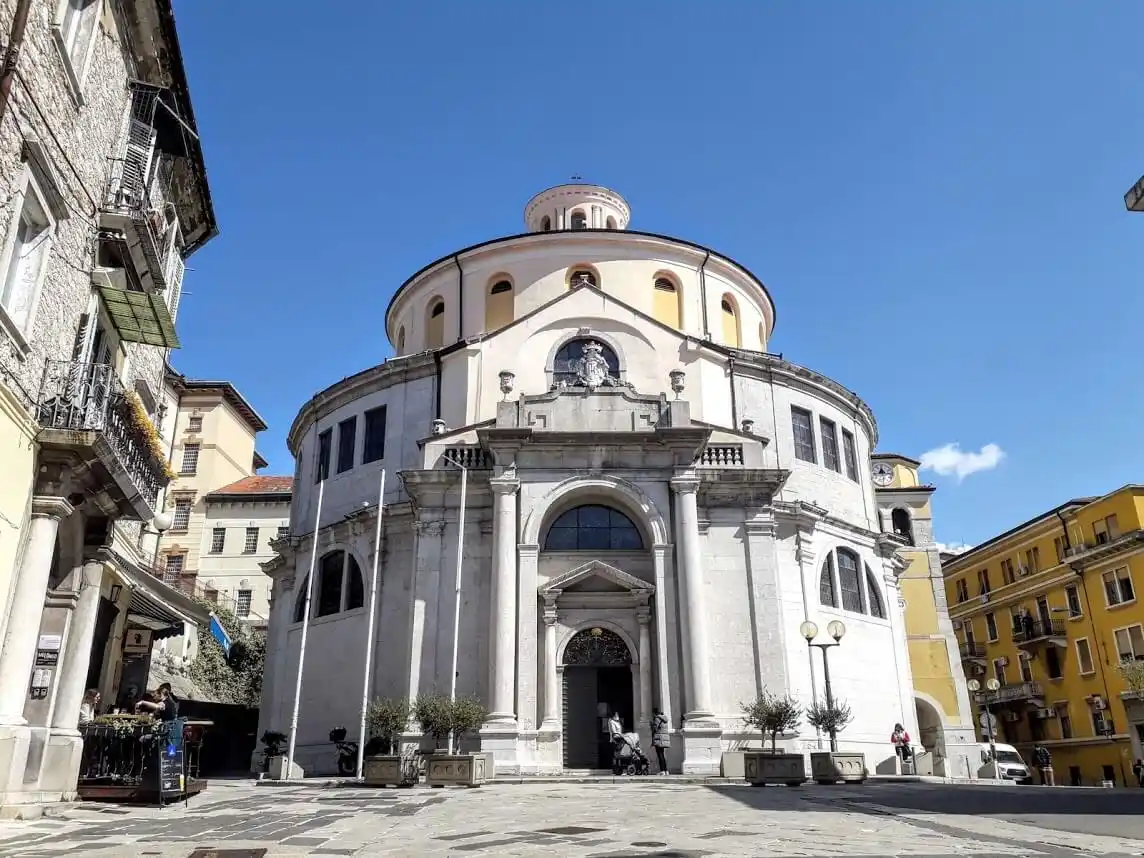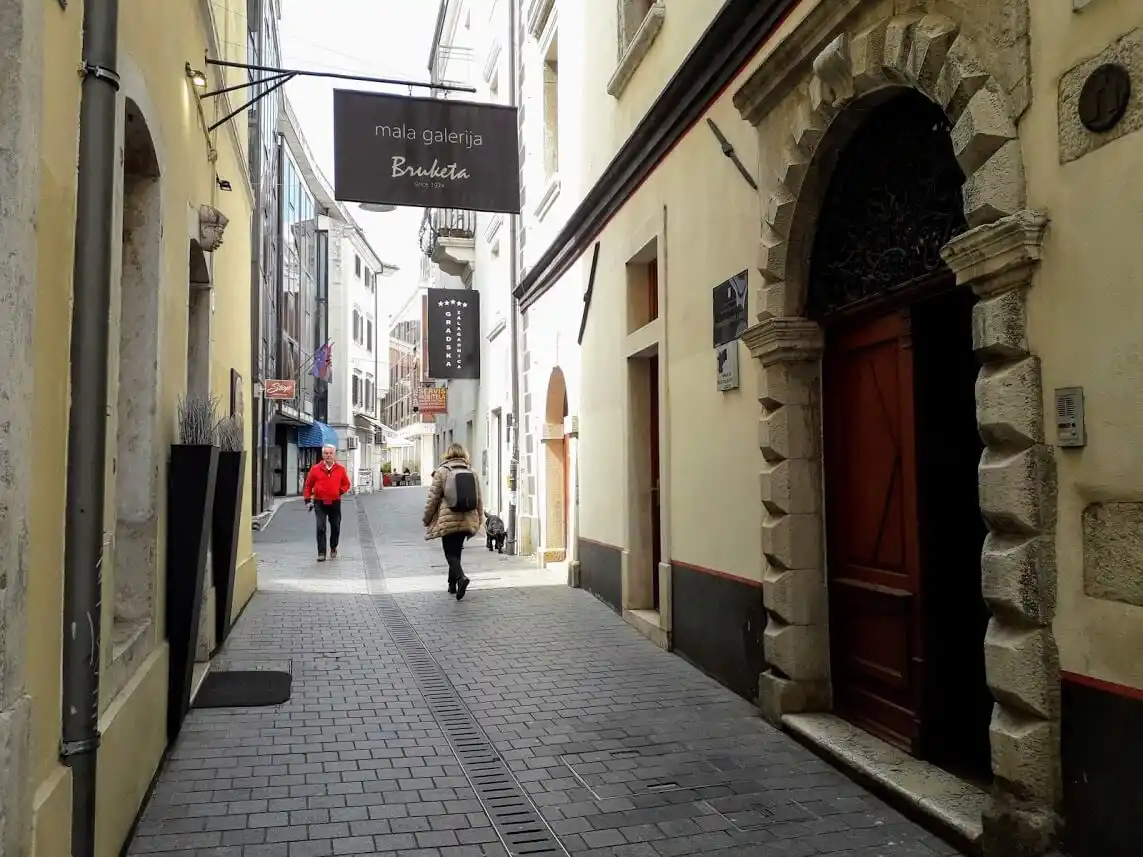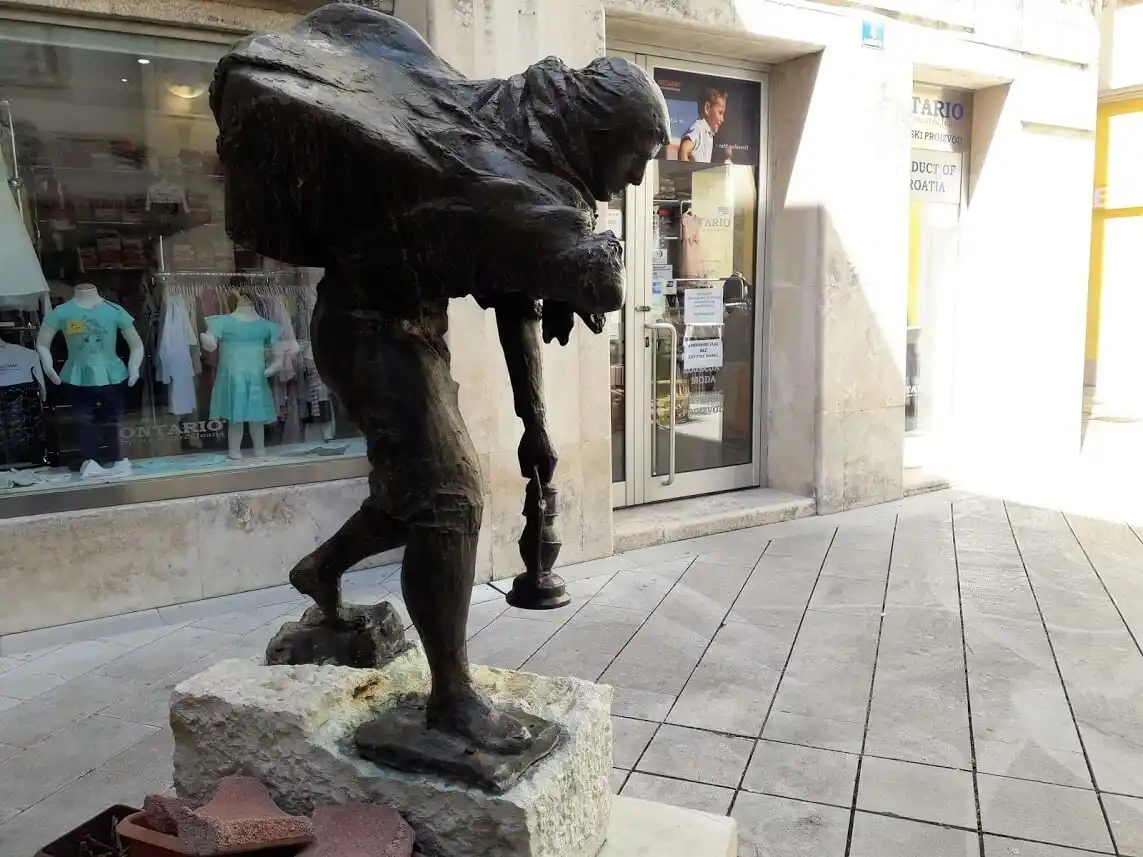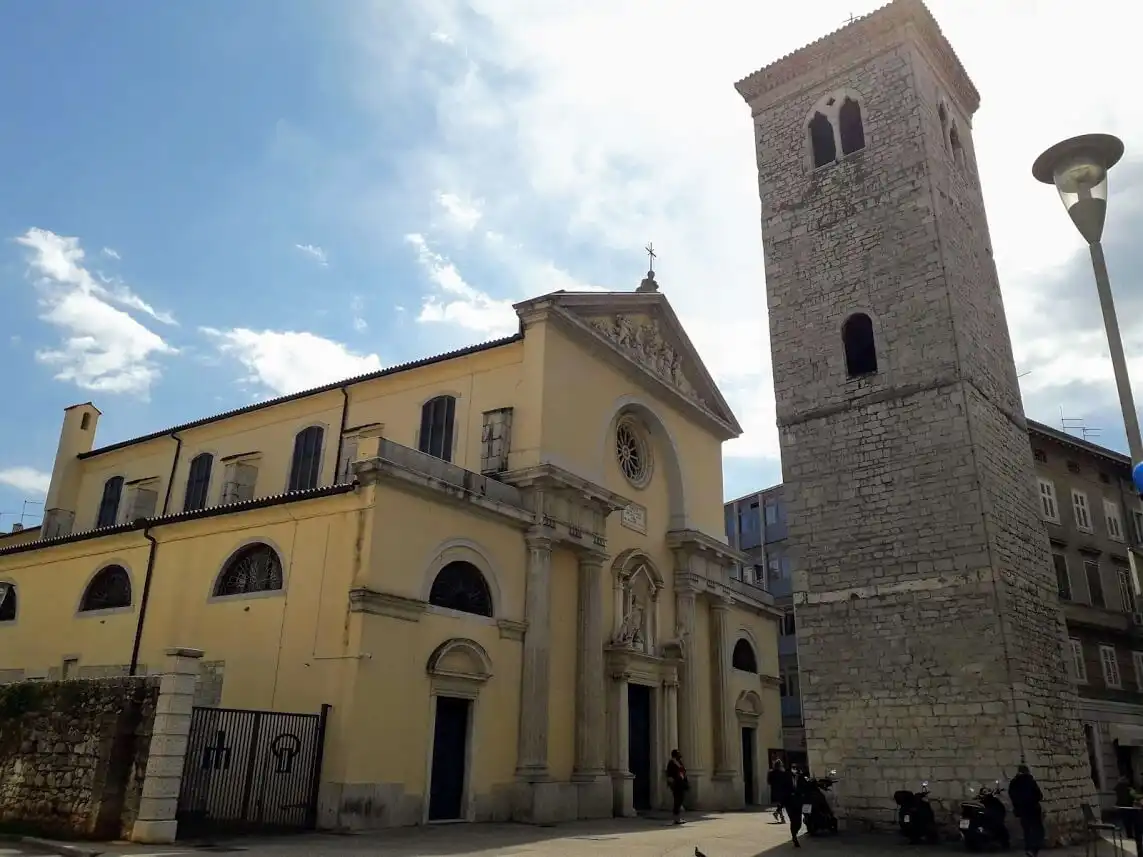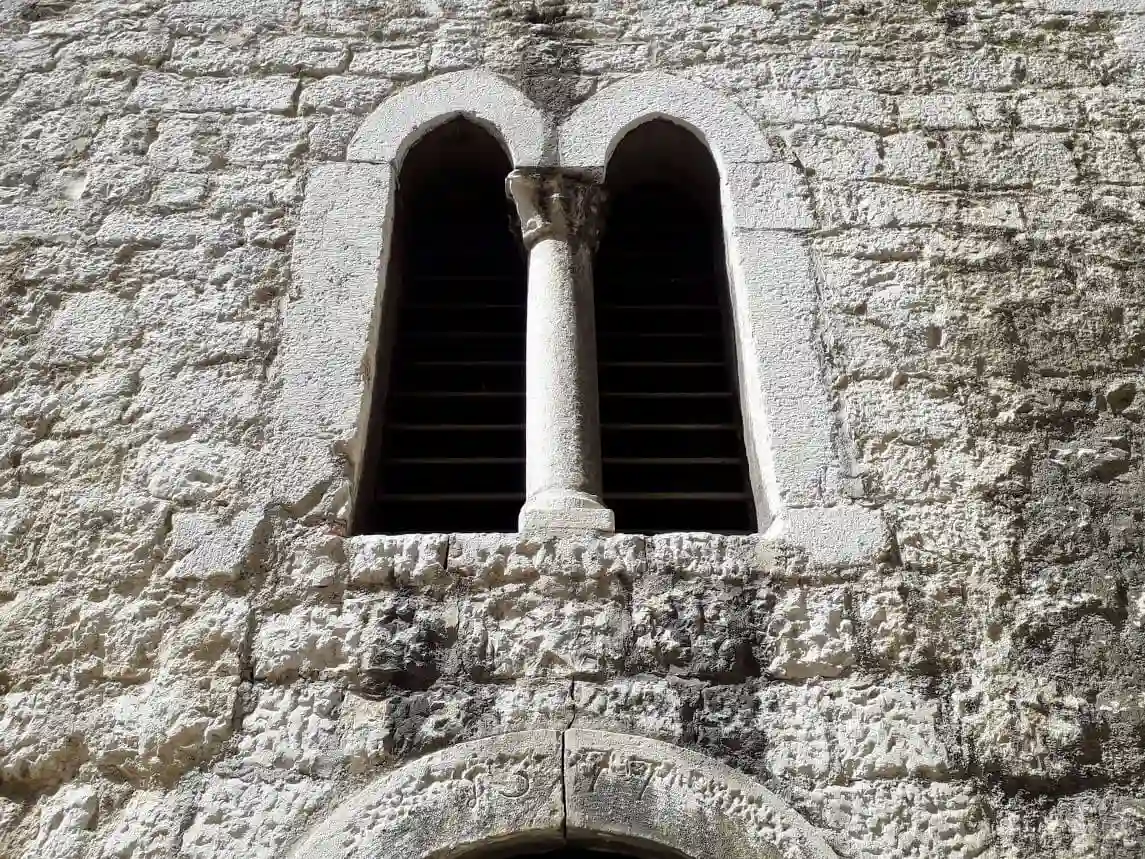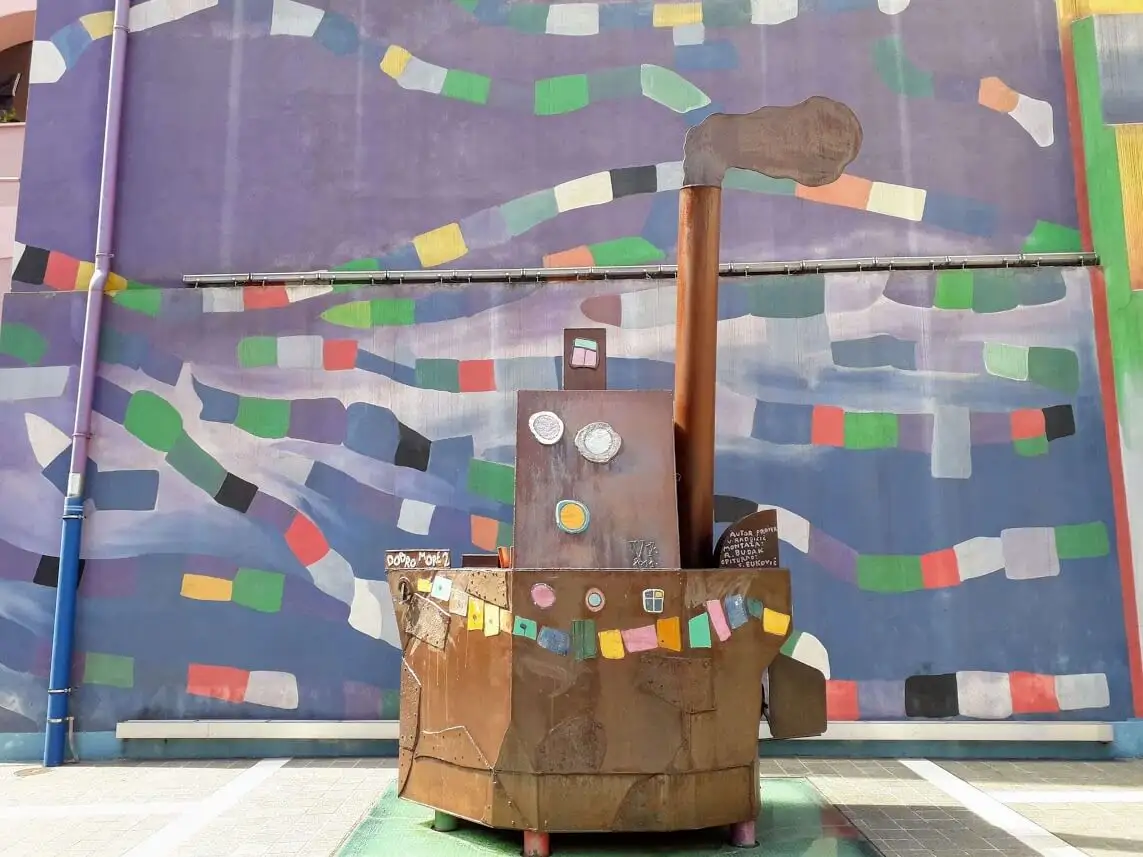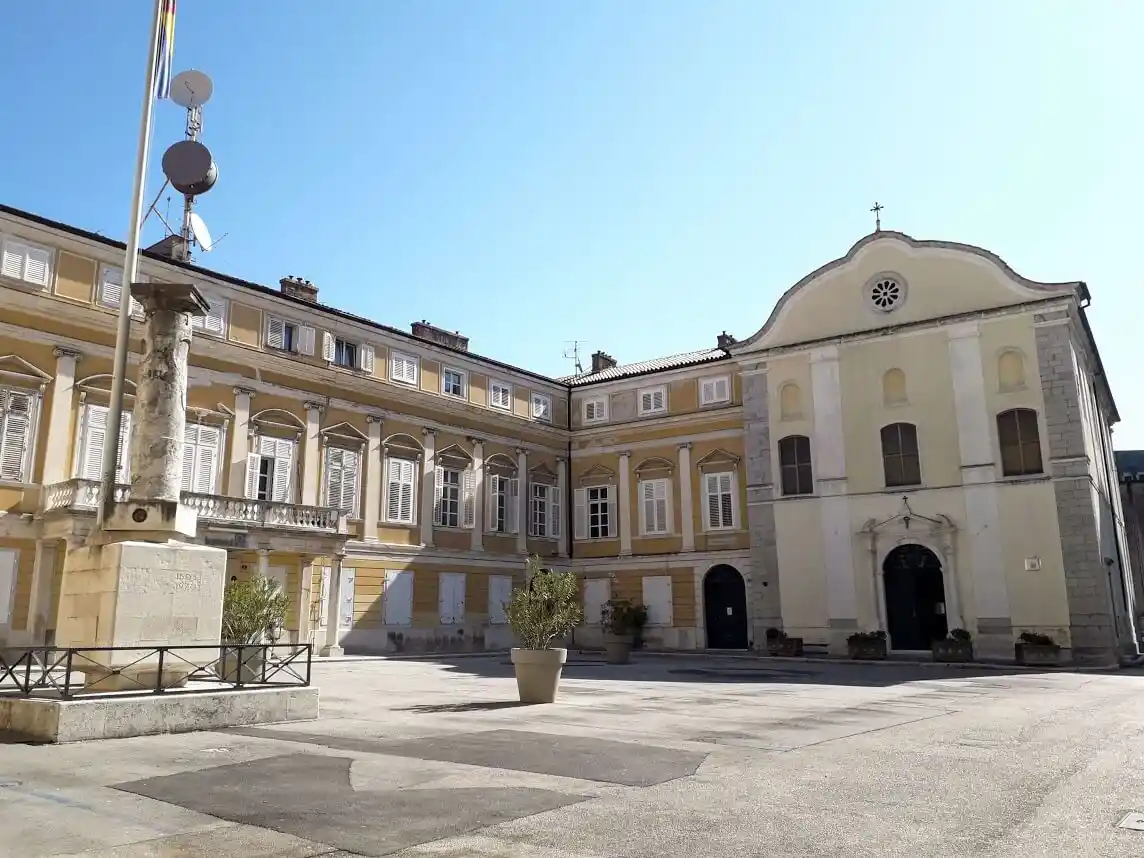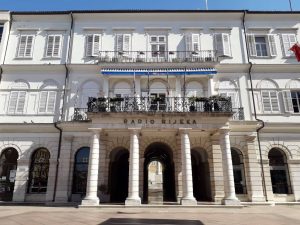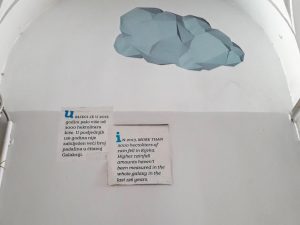Situated in the northern part of the Croatian coastline, Rijeka is the third-largest city in the country. In Croatian, Rijeka literally means river. Because of the river Rječina, its location next to the coastline, and lots of rain it’s popularly called ‘the City that Flows’ among the locals. Despite that, it actually has a lovely Mediterranean climate. The city is multicultural and multiethnic, very rich in history and culture and a charming town to visit while in Croatia. With the help of this Rijeka City Guide, you can take a walk through the historic centre of Rijeka and explore some of its beautiful buildings, monuments and fascinating history.
Rijeka City Guide
Rijeka – the Capital of Culture 2020
Rijeka’s cultural programs are especially interesting right now because the city won the European Capital of Culture title for 2020. You can still see some of the projects made for that occasion at the Sugar Refinery Palace, Museum of the City of Rijeka and the Children’s House.
⤷ Read more: Best places to visit in Croatia
A brief history of Rijeka
Let’s start this Rijeka City Guide with its brief history. Although first mentioned in the 13th century, the long history of Rijeka begins in Prehistory, and the city has been inhabited since then. It first consisted of a couple of settlements on the site of today´s Rijeka. They were surrounded by a massive Roman defensive wall called limes, which can still be seen in Kalvarija street.
An area of the city known today as Stari grad (eng. Old Town) was first called the City of Tarsatica during the Roman time. Throughout history, Rijeka was a part of many countries, destroyed and renewed a few times, but continued to exist in the same place.
It’s been sieged by Slavic and Avar tribes, under the rule of the Byzantine Empire, probably destroyed by Franks in 799, and then by Venetians at the end of the Middle Ages. It was severely damaged in a great earthquake in 1750. After that, the Roman walls were demolished so the city could expand.
As a part of the Austro-Hungarian Empire, Rijeka became its strategic port and industrial centre. The new area located closer to its port neglected the Old Town, which became poor and eventually ruined during the Second World War. After it, a plan for replacing the old houses with twelve new skyscrapers appeared. Luckily, a local architect Igor Emili protested against it. He developed a plan to preserve the historical centre of Rijeka by reviving it and incorporating new buildings behind the old facades, giving Rijeka’s historical centre today’s appearance.
⤷ Read more: Things to do in Zagreb 2024: Tips from a local
What to see in Rijeka
Rijeka’s Korzo
Address: Korzo, Rijeka
Korzo is the main Rijeka’s promenade where both locals and tourists enjoy taking a walk in a relaxed atmosphere. It used to be Rijeka’s main street, busy with carriages passing by. It still preserves a bit of that historic feel with elegant Art Nouveau style buildings it’s surrounded with.
It’s also a location of Rijeka’s Christmas Market (Rijeka Advent) and many spring fairs. You can buy good quality local food like honey, prosciutto, pancakes, and all kinds of other souvenirs during them.
During Christmas, you can even pay a symbolical charity donation at one of the stands, and get an ornament to place on a massive Christmas tree there.
⤷ Read more: Istria Travel Guide & The best places to visit in Istria
Rijeka City Tower
Address: Trg Ivana Koblera 1, Rijeka
You can enter Rijeka’s Old Town in few places. However, the most interesting way is through Gradski toranj (eng. the City Tower). It’s located on Korzo, and it used to be the main entrance to the town. The old city walls and defensive trenches were found in a place of today’s buildings next to the tower.
Although it’s very decorative today, we know it started as a simple gate back in the 16th century from the old maps and graphics. The wooden doors were closed each night at the same time, so the city was protected that way.
Throughout history, the gate eventually became a tower with a clock and reliefs depicting two Austrian emperors quite important to Rijeka. Charles VI assigned a privileged status of a free royal port, which helped the city grow. Another one, Leopold I, approved its coat of arms with a two-headed eagle standing on a river spring with the inscription ‘without deficit’.
The tower got a Baroque appearance similar to today’s after a strong earthquake that hit Rijeka in 1750. The empress Maria Theresa allowed the city then to expand beyond the walls. In 1906, the sculpture of Rijeka’s two-headed eagle was placed on the top of the tower.
The story says Rijeka’s citizens were so proud of it, they celebrated long into the night. And it stayed important to locals until nowadays. It’s also a popular meeting place in Rijeka for centuries.
During the short D’Annunzio’s occupation, in 1919, the eagle lost one of his heads. A soldier assumed it was an Austrian eagle, though Rijeka’s eagle’s heads are turned the same way, unlike Austrian. The eagle was removed, and a replica was only put back a century later, in 2017.
⤷ TIP: A lovely place for a coffee break during your walk through the city of Rijeka could be Café Nad Urom (meaning, Above the Clock Tower). It’s located on the top floor of the Korzo Mall. You’ll have a great view of Rijeka’s city centre, Korzo, and the City Tower up close!
Kobler´s Square
Address: Trg Ivana Koblera
Entering through the City tower, you’ll arrive at Kobler´s Square. It’s a vibrant place filled with cafes and shops. The square is a location of the Town Hall, and it used to be the centre of Rijeka’s city life before the destruction of its walls.
The Town Hall building has a long and interesting history. Built as a residential house, it was turned into a town hall in the 16th century and rebuilt in the Baroque style afterwards. Later on, it was sold once again and served as a birthplace of a famous composer from Rijeka, Ivan Zajc. To honour that important man, the city theatre was named after him.
At the centre of the square, an unusual fountain made by a local architect Igor Emili is located. It was made in collaboration with Rijeka’s Paper Factory. The water flows from an old mill the factory had used for grinding paper. It became a symbol of the working-class and life-giving water connected to the well on Rijeka’s coat of arms, justifying its popular nickname ‘The City that Flows’.
⤷ Read more: Colourful history of Istria: Medieval frescoes in Istria
Principij – Roman Castrum
Address: Ulica Stara vrata 3, Rijeka
A place you shouldn’t miss in Rijeka is an ancient Roman ruin located in the middle of its Old Town. Principi (or in Croatian version Principij) is a Roman name for a military camp or Roman Castrum.
Rijeka’s Principij was built during the 3rd century. You can enter it through the ancient arc known as Stara vrata (eng. Old Gate), located next to the Town Hall. They served as the entrance to the military camp.
It originally consisted of outer walls, a building with columns inside of them, surrounded by smaller rooms for soldiers, outbuildings, and a square in its centre for gatherings and religious purposes.
Today, the archaeological site consists of foundations only. However, recently added piers mark locations where the walls once stood.
⤷ TIP: Be sure to climb a small platform, from where you can enjoy a lovely view of the whole structure, all that while surrounded by small Baroque houses, Emili’s modern glass buildings, and the Principij Gallery with photography exhibitions.
Saint Vitus Cathedral
Address: Grivica ulica 11, Rijeka
Following the narrow passage next to the Principij Gallery, you’ll get the next stop of this Rijeka City Guide –Saint Vitus Cathedral. That former Jesuit church is located near the former northern entrance to Rijeka’s Old Town.
Saint Vitus Cathedral was built during the 17th and 18th century. It has a characteristic round shape that’s influenced by Venetian churches from the same time.
You can see beautiful marble columns and arches in its interior, together with some interesting paintings and statues. One of them is a famous gothic crucifix. According to the legend, it started bleeding once, when an angry card player threw a stone at it after losing in a game.
The Jesuit Order also founded a College and seminary with a library. Their old books and manuscripts became the foundation for the University of Rijeka Library.
⤷ TIP: Next to the church, there is an entrance to an underground World War II shelter. Since recently, it’s open to visitors. There’s also a souvenir shop called Croatia in a Box, where you can buy some nice good-quality Croatian products, like olive oil or umbrellas printed with Rijeka-themed paintings of local artists. A visit to that cool local store should definitely be on you Rijeka City Guide list.
Užarska street
Address: Užarska ulica
You can take a pleasant walk through narrow, peaceful pedestrian Užarska street from the Town Hall. It was the main street of roman Tarsatica called decumanus. It was a characteristic main street each city built by the Roman Empire had.
Something quite characteristic for Rijeka is that locals don’t get oriented by the street names but rather by iconic buildings or cafés. However, Užarska is one of those streets that’s well-known. It´s packed with some lovely souvenir shops, like an art shop Gallery Bruketa and the store called Šta da?. Besides shirts and souvenirs with that phrase, you can find a hugely popular car sticker, ‘Volim grad koji teče’ (eng. I love the City that Flows).
⤷ TIP: Šta da? is a widely-used local slang word meaning Really?. It’s only used in the Rijeka region of Croatia.
Some other interesting spots at Užarska street are the Museum of Pharmacy and the Conservation Institute. If you’ll explore the street really carefully, you’ll stumble upon details like an old drinking fountain on one of the walls there.
Mljekarski trg – Dairy Square
Address: Mljekarski trg
Walking through Užarska street, you’ll pass by a small square called Mljekarski trg (eng. Dairy Square) with a statue of a milkmaid.
It represents women that used to sell fresh milk to the citizens of Rijeka. They would wake up at dawn and walk around fifteen kilometres each day from villages located at Grobnik. Each one of them would carry a couple of heavy buckets in a large bag on their back and additional ones in their hands.
When they arrived at the square, milkmaids would loudly shout and try to attract customers, who could taste the milk before buying. The tradition lasted from the 19th century until the 1990s, and it´s being remembered by yearly commemorations.
⤷ TIP: In most supermarkets in Rijeka, you’ll find dairy products from the local brand Tonka, named after one of the milkmaids.
The Church of Ascension of the Blessed Virgin Mary
Address: Ulica Pavla Rittera Vitezovića 3, Rijeka
Although older, Crkva Uznesenja Blažene Djevice Marije (eng. Church of Ascension of the Blessed Virgin Mary) was rebuilt in a neoclassical style in the 19th century. However, the archaeological excavations discovered the whole ancient underground world beneath it. Under the church and steeple, the remains of ancient Roman thermal baths and a Roman coffin were found. Also, underneath was an early Christian church from the 5th century recognized by the well-preserved floor mosaic.
Chuch interior is decorated with rich plaster wall ornamentation. The main altarpiece contains a painting influenced by the famous masterpiece ‘Assunta’ made by the Venetian painter Titian.
The author of one of the altarpieces is Antonio Michelazzi. He is the same sculptor who renewed the City Tower after the earthquake and worked on decorating the Saint Vitus Cathedral.
⤷ Read more: Journey through history on Batana boat in Rovinj
Kosi toranj – the Leaning Tower of Rijeka
Address: Ulica Pavla Rittera Vitezovića 3, Rijeka
The tower in front of the church is called Kosi toranj (eng. the Leaning Tower). The reason it leans is probably that it was built over the medieval wall and an underground stream. Researchers are still not sure when exactly was it made. But it was renovated throughout history and changed its appearance more than once.
The tower was much shorter originally. The old Rijeka’s city regulations were quite clear; anything too high would be an easy target for enemies.
Like many other locations in this Rijeka City Guide, the tower was damaged in the Venetian siege in 1509, while the Second World War bombing probably caused further leaning. The last restoration from a century ago brought back its Romanesque appearance.
⤷ TIP: Some time ago, a Late Antiquity mosaic was found next to Rijeka’s leaning tower. You can see it today at the Garbas Palace in Užarska street, where it was relocated.
Colourful squares
Address: Trg Matije Vlačića Flaciusa and Pavlinski trg
On your way to the next location of our Rijeka City Guide, you’ll pass over a peaceful painted square Trg Matije Vlačića Flaciusa. It’s home to an urban garden and a lovely tea-place Samovar.
Almost adjoined to it is Pavlinski trg (eng. Pavline Square) with a lovely children’s playground, a mural and a ship sculpture made by the well known local artist Vojo Radioičić.
⤷ TIP: You’ll also pass near an ambiental Baroque house transformed into the restaurant Primorska konoba, where you can try some regional food.
The Square of Rijeka’s Resolution
Address: Trg Riječke rezolucije
The last place to see on this historical walk through Rijeka is the Order of Saint Augustin Monastery. It was first mentioned in the 14th century when the church and monastery were built in the Gothic style.
Although, later on, they were renovated in the Baroque style, you can still see the Gothic fragments both inside and outside. They are recognizable by pointed windows and buttresses made of stone.
The Square of Rijeka’s Resolution was designed at the time of influential governor Giovanni Ciotta. During his reign in the 19th century, many new public buildings were built in Rijeka. Apparently, this square was a favourite place for local children to play handball in his time.
When the Municipal Palace was renewed, the city council moved there from the old Town Hall.
You’ll also find an old stone flagpole in the central part of the square. Although it’s marked with the year 1530, the monument is definitely older than that. It was relocated around Rijeka a few times, and we don’t know where it was installed initially.
You can leave the square through a hallway of the Radio Rijeka building. It was a place where an important Rijeka Resolution was signed in 1905, hence the square’s name. Croatia demanded a better position within the Austro-Hungarian Empire by that document.
⤷ TIP: Its hallway also makes a perfect ‘waiting room’ for the infamous Rijeka’s rain to pass, with walls decorated by cloud stickers and funny statements about Rijeka´s rain.
The historical centre of Rijeka is full of picturesque narrow streets, Baroque portals, old facades and paving and exciting stories. If you’re wondering about the places you should see in Rijeka, be sure to visit some from this Rijeka City Guide.

